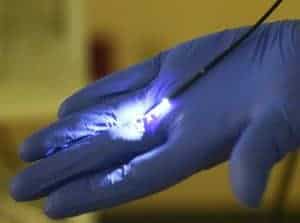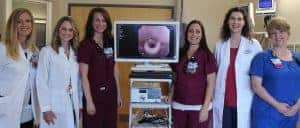Fiberoptic Scope Procedure Shines Light on Baby Swallowing
| Aug. 24, 2017 | All parents closely monitor their babies in the first weeks of life for milestones: he grabs your finger; she gazes into your eyes; he starts responding to noises.
But in the neonatal intensive care unit (NICU), baby’s first milestones take on even more meaning. They can be a sign of the baby’s health, and they can mean the difference between staying in the hospital and going home to be with family.
Progress can be celebrated in increments, and in the case of babies like Brixen, born five weeks early, it can be measured in fluid-ounces.

The emergence of smaller fiberoptic scopes has allowed the swallowing procedure to be conducted in NICU babies.
“He took a whole bottle today. Before, he wasn’t even drinking half,” said Lionel Whittamore, of Benton, Brixen’s father, with pride, catching his wife’s eyes. They shared what seemed like a still moment with a smile, while outwardly, life continued to swirl around them, specifically in the form of Huntley, 4, and Trace, 2, who were bopping around Brixen’s NICU room in matching overalls and who could have been twins except for a couple of inches of height, one blonde, one brunette.
One-month-old Brixen wiggled quietly in his mother’s arms while she, Stephanie Whittamore, and her husband told the story of his arrival.
“He has been so healthy in so many ways, it’s just his feeding that has been a problem,” Stephanie said. “All I want is for him to get better and come home.”
“If we can get him up to eight bottles a day, we can do that, we can bring our little guy home,” Lionel said.
Brixen’s feeding improved after his formula was thickened. UAMS speech pathologists working in the NICU were able to confidently identify the problem and consult with his treatment team to recommend the thickening because they were able to take a video with a fiberoptic scope through his nose and above his throat while he swallowed milk. They were able to see that he was having trouble swallowing properly and keeping the thinner milk out of his airway, causing him to aspirate and not want to take the milk.
This procedure (fiberoptic endoscopic evaluation of swallowing, or FEES) has been common at UAMS to evaluate swallowing in adults for more than 15 years, but only a few hospitals in the country have started recently applying the technology – with the help of smaller scopes – to NICU babies. On June 26, UAMS was the first hospital in Arkansas to perform the procedure on NICU babies, and its speech pathologists have performed several more similar procedures in the weeks since.
An alliance with pediatric ear, nose and throat (ENT) staff at Arkansas Children’s is in place so cases can get the follow-up treatment they need.
“UAMS is constantly striving to improve the practice and the quality of care provided to both premature and sick full-term infants and their families,” said Sara Peeples, NICU medical co-director. “ Implementation of this process is an example of the interdisciplinary collaboration that is the hallmark of our NICU: nursing, physicians, speech therapists, our pediatric ENT colleagues at Arkansas Children’s, patient education, and others worked together to make this possible. This has been the standard for many of the quality-improvement and evidence-based practice changes in our unit, and one of the things I like most about working here.”
The procedure has several advantages. Previously, the baby would have had to travel to Arkansas Children’s Hospital for a swallow study to be performed and would have swallowed barium products that are visible under X-ray. A video swallow study can’t be done with breastfeeding mothers and exposes the patient to radiation.
Alternatively, this procedure can be done at the bedside in the UAMS NICU, can be done while a mother is breast feeding her baby, and allows the speech therapists to evaluate different interventions or feeding positions in real time. This evaluation can give parents and health care providers peace of mind because it takes the guesswork out of whether the babies are swallowing correctly and safely. For some, that may mean additional much-needed treatments, but for others, it could confirm that they are swallowing well and can go home sooner than they otherwise might have.
Because they are one of the first in the nation to use the procedure on NICU babies, Peeples hopes UAMS will be able to contribute to the body of emerging research into the technique and that the tool will be an educational opportunity for the medical staff and parents alike.
For now, little Brixen is working hard to accomplish the goals that will help him join his family at home. Today, he is working on each swallow, so that tomorrow, he can be healthy enough to join his energetic older brothers in the many milestones that lie ahead.

